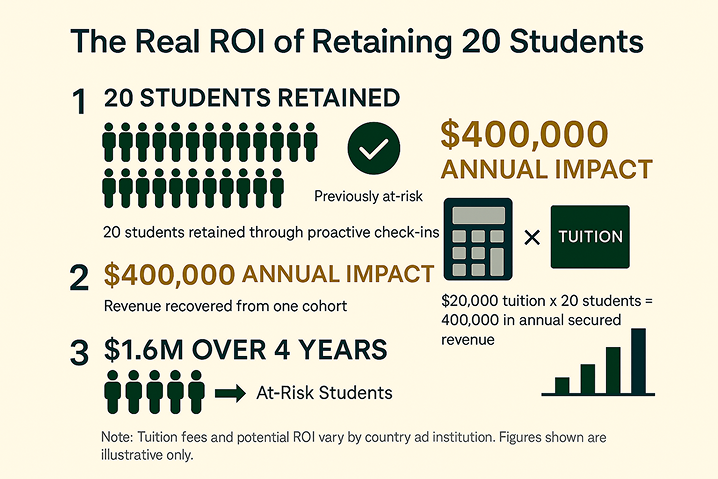
Higher education institutions today operate in an environment of increasing financial scrutiny and heightened expectations for demonstrable outcomes. Every investment, whether in technology, personnel, or programming, requires clear justification. While the importance of student satisfaction is widely acknowledged , traditional methods of gauging it often fall short of demonstrating tangible returns. Can systematically listening to students, not just through annual surveys but through continuous, actionable feedback loops, deliver a measurable Return on Investment (ROI)? We argue that it can, and that platforms like StudentPulse are key to unlocking this strategic value.
Moving beyond simple satisfaction scores requires reframing student feedback not just as a measure of contentment, but as a vital source of intelligence that can drive improvements in retention, resource allocation, operational efficiency, and ultimately, the institution's bottom line.
Student retention is arguably the most direct link between student feedback and financial ROI. Losing a student represents not only a loss of tuition revenue for subsequent terms but also the loss of the initial investment made in recruiting and onboarding that student. Conversely, retaining a student secures ongoing revenue and contributes to cohort completion rates, a key metric for institutional reputation and funding.
The challenge lies in identifying students who are struggling before they decide to leave. Traditional surveys often capture dissatisfaction too late. StudentPulse check-ins, however, provide continuous, real-time insights into student well-being, engagement, and potential challenges. The platform's ability to identify at-risk students reporting a 14% increase in identification compared to traditional methods, allows for timely, targeted interventions.
Consider this hypothetical ROI calculation: Imagine a mid-sized university with an undergraduate tuition of $20,000 per year. If implementing StudentPulse helps the institution retain just 20 additional students per year who might otherwise have dropped out, that translates directly to $400,000 in secured tuition revenue annually. Over a typical four-year degree program, the cumulative revenue impact from retaining that single cohort could reach $1.6 million, far outweighing the investment in the feedback platform. By enabling proactive support based on real-time data, StudentPulse directly contributes to stabilizing enrollment and maximizing tuition revenue.

Universities invest heavily in student support services – academic advising, tutoring centers, mental health counseling, career services, and more. But are these resources aligned with actual student needs? Are they accessible when and how students require them? Guesswork and anecdotal evidence are inefficient ways to allocate budgets.
Aggregated, anonymized feedback data from StudentPulse check-ins can provide a clear picture of student demand and satisfaction with existing services. For instance:
By revealing patterns in student needs and service utilization, this data allows administrators to make informed decisions about resource allocation. Perhaps funding needs to shift towards expanding online tutoring options, increasing counselor availability during peak stress periods, or redesigning career workshops based on student feedback. This data-driven approach ensures that limited resources are deployed effectively, maximizing their impact on student success and potentially reducing expenditure on underutilized or ineffective programs.
Critical transition periods – the first year, the transfer process, returning after a break – are high-risk points for student attrition, often referred to as "melt". Students navigating new academic expectations, social environments, and administrative processes can easily feel overwhelmed or disconnected.
Deploying targeted StudentPulse check-ins during these crucial phases allows institutions to identify and address concerns early. Are first-year students struggling to register for courses? Are transfer students finding it difficult to integrate socially or academically? Are returning students aware of updated campus policies? Addressing these issues proactively through automated information delivery or personalized outreach triggered by check-in responses can significantly improve the onboarding experience, foster a sense of belonging, and reduce the likelihood of students dropping out before they even truly begin. Preventing melt preserves enrollment numbers and ensures students successfully embark on their academic journey.
The value of student feedback extends into the core academic mission. Aggregated insights from check-ins regarding course experiences – perceived relevance of content, effectiveness of teaching methods, challenges with workload or specific concepts – provide invaluable data for academic departments and administrators. This information can inform:
Furthermore, the automation inherent in the StudentPulse platform boosts operational efficiency. Manually collecting, collating, analyzing, and routing feedback from traditional surveys is incredibly time-consuming for staff. StudentPulse automates much of this process – from distribution and collection via check-ins to AI-powered analysis, trend identification, and stakeholder reporting. This frees up valuable staff time, allowing them to focus on higher-impact activities like developing interventions and engaging directly with students, rather than getting bogged down in data administration. This efficiency gain represents a significant, though sometimes harder to quantify, component of the platform's ROI.
In an era demanding accountability and efficiency, higher education leaders must look beyond traditional metrics. Student feedback, when gathered continuously and acted upon systematically, is far more than a measure of satisfaction – it's a strategic asset.
Platforms like StudentPulse provide the mechanism to unlock this value. By enabling proactive retention efforts, optimizing the allocation of support resources, smoothing critical student transitions, informing academic strategy, and boosting staff efficiency, StudentPulse delivers a compelling Return on Investment. It transforms the act of listening into a powerful engine for institutional effectiveness, financial health, and ultimately, enhanced student success. Investing in proactive, actionable student feedback is not just good practice; it's a smart strategy.
Curious what ROI looks like for your institution? Grab our free Whitepaper and get the template to run the numbers yourself.
